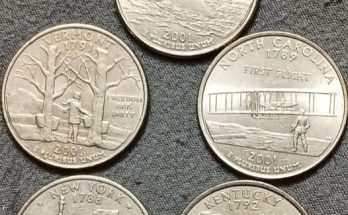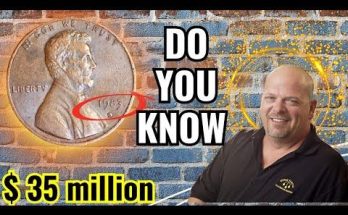The Coinage Act of 1965 removed silver entirely from dimes and quarters and modified the half dollar so that some silver would remain in the 50-cent coin, albeit at a debased 40% silver-clad composition. Coins dated 1965-1970 were struck in this manner, which proved a serious impediment to their circulation. By 1970, Congress had seen enough, and for the 1971 Kennedy Half Dollar, the composition was changed to the same copper-nickel sandwich metal used for the dime and quarter. This occurred at the same time that legislation to reintroduce the dollar coin was being debated, which was also issued into circulation as a base metal coin (but with a 40% silver collector version that the United States Mint sold at a premium).
In its clad format, the Kennedy Half Dollar saw increased circulation – but not to the level of the Mint’s lower-denomination coins. Vending machines and modern cash register tills just weren’t set up for the bulky coins. After an emission of 450 million coins in 1971, the mintage for the 1973 issue had fallen to 148 million (the Mint saw similar declines in demand for the Eisenhower Dollar, which in 1973, was produced exclusively for Mint Sets).
The nation’s Bicentennial celebration provided the Mint with an opportunity to reintroduce the public to the half dollar and dollar coins thanks to legislation authorizing the production of commemorative versions of these coins. In addition to the standard clad issues, the Mint was instructed to make 40% silver versions of the Washington Quarter, the Kennedy Half Dollar, and the Eisenhower Dollar in Uncirculated and Proof finishes, which were sold to collectors through the Mint’s store and other venues.
Bicentennial coinage was issued for two years (1975-76), and coins issued in both years featured the dual date of “1776-1976”. The reverse designs were selected from a pool of 884 entries; a five-judge panel of experts then selected the winning designs.
The three winning designs were submitted by either commercial artists, or in the case of the Dollar, an art student. Jack Ahr, designer of the Bicentennial Quarter reverse, was the owner of his own commercial art company. Seth G. Huntington, designer of the half dollar reverse, worked as the head of the art department at the marketing firm of Brown & Bigelow. And Dennis R. Williams, the designer of the Eisenhower Dollar’s Bicentennial reverse, was an art student at the Columbus College of Art and Design in Ohio. Each received a $5,000 prize and struck the first of their respective coins at a ceremony in Philadelphia. None of the winners ever produced another coin design for the United States Mint.
The Bicentennial Kennedy Half Dollar was the first of the three coins to be issued, at a ceremony in Huntington’s hometown of Minneapolis held on July 7, 1975. The 40% silver-clad Kennedy Half Dollars were struck at the San Francisco Assay Office, with approximately 11,000,000 business strikes and approximately 4,000,000 Proof strikes manufactured. The Treasury Department authorized the manufacture of the silver-clad coins through the end of 1976, but given the lack of demand, coin production concluded in June. Sets were sold at an issue price of $9 each ($51.10 in 2024 inflation-adjusted dollars).
The exact total of the 1976-S Kennedy Silver-Clad Half Dollars sold remains an open question. The Mint continued to sell the sets in trickles through the early 1980s. Many were likely destroyed during the Great Silver Melt of the late ’70s and early ’80s. Whatever number lost to the crucible, does not diminish the commonness of the set, which sells today for under $20. Quite a poor return over time, but not a bad value today given the current spot silver spot price.
The United States Bicentennial Silver Uncirculated Set

The Bicentennial Silver Uncirculated Set was initially issued in a red envelope, which read “United States Bicentennial Silver Uncirculated Set 1776-1976”. On October 28, 1976, the United States Mint issued a press release to announce new holiday packaging for the three-coin set.

Orders placed after October 1 and through December 31, 1976, were shipped in the holiday packaging. Given the narrower ordering window, the Holiday Set is much scarcer than the standard set, yet these sets sell for the same price.

Inside the envelope, the three silver-clad Bicentennial coins are houses in a sealed plastic pouch, which sits inside of a cardboard shell.

Included is an insert card, which provides information about the coins and states that “these coins have never been released for circulation.”
Collecting the 1976-S Kennedy Silver-Clad Half Dollar
The 1976-S Kennedy Silver-Clad Bicentennial Half Dollar is easily acquired in raw form, as part of the three-coin set in its original packaging, and as a certified coin in grades MS66 to MS67. In MS68 and above, the coin is conditionally scarce, largely due to incidental contact marks in the fields and on Kennedy’s face and hairline.

In grades MS65 to 66, expect to pay between $10 and $20 for an example. In MS67, this price rises to about $35. At MS68, examples sell for over $100 each.
One of the first MS69 1976-S Kennedy Silver-Clad Half Dollars certified by PCGS was submitted by Ike Dollar specialist Brian Vaile. Vaile was one of the early popularizers of the 1971-D Eisenhower Dollar, Friendly Eagle Variety, which was not yet a Cherrypicker’s Guidevariety. According to Vaile’s research partner Rob Ezerman, Brian kept his nearly perfect 1976-S Kennedy Half Dollar on his desk for more than a year before he decided to submit it. The most recent sale of a PCGS MS69 1976-S Kennedy Silver-Clad Half Dollar occurred in May 2024, where the coin sold for $5,242.50. This is quite a bit lower than the apparent record price of $16,312.50 realized the year before. MS69 examples seem to appear exclusively in GreatCollections auctions as we found no records at either Stack’s Bowers or Heritage.
* * *
Market Data and Noteworthy Specimens
Top Population: PCGS MS69 (5, 12/2024), NGC MS69 (5, 12/2024), and CACG MS67 (1, 12/2024).
- PCGS MS69 #45654684: GreatCollections, March 19, 2023, Lot 1336549 – $16,312.50; GreatCollections, August 6, 2023, Lot 1390437 – View; Dip residue in the lower left obverse field. Discoloration in the upper left reverse field. Dip residue throughout the reverse.
- PCGS MS69 #47487861: GreatCollections, October 8, 2023, Lot 1403894 – View; GreatCollections, May 19, 2024, Lot 1582380 – View. Dip residue above G, to the left of Kennedy’s lips, and above T. On the reverse, more dip residue below AMERICA.
- PCGS MS69 #47452644: GreatCollections, July 30, 2023, Lot 1403889 – View. Dip residue near rim above IN.



